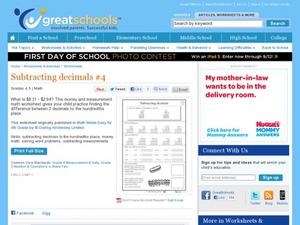Curated OER
Ordering Large Numbers: Numbers up to 9,200,000
Once learners understand place value, they can put all kinds of numbers in order - even eight-digit numbers! Fourth graders put groups of five numbers in order from smallest to largest. After they finish, they decipher a word problem and...
Curated OER
Putting Numbers in Order, Numbers up to 100
Party with number balloons! Young learners study four groups of illustrated balloons with numbers on them, and write the numbers in sequence from smallest to greatest, or greatest to smallest. For extra fun, have them color the balloons...
DK Publishing
Putting Numbers in Order, Numbers Up to 9,900
Put these big numbers in order! Fourth graders review the example at the top of the page before putting 16 sets of 4-digit numbers in order from smallest to largest. You can cut the three sections of problems into strips of paper for...
Curated OER
Subtracting Decimals #3
Practice money and measurement math with a thorough learning exercise. Two examples at the top of the page remind fourth graders how to solve subtraction problems using decimals. After working through 14 problems, they then solve two...
Curated OER
Subtracting Decimals #4
Practice subtracting decimals to the hundredths place. This assignment includes amounts of money and units of measurement. Three sections of problems provide subtraction problems in both vertical and horizontal formats, as well as two...
Curated OER
Morning Math
Here is a series of morning math activities which will get your class thinking as they start the day. Simply do one or two every day; the variation in types of math will keep them on their toes and reviewing past concepts. Each of the 16...
Curated OER
Multiplication Drills
Practice multiplication with your fourth graders! After reviewing four example multiplication problems at the top of the page, pupils solve 32 problems with one and two-digit numbers. This format would work well for a nice timed-quiz for...
Curated OER
Real-life Problems, Working with Decimals
Put your learners' decimal skills to the test with these five word problems. With space for students to write their work, the word problems contain addition and multiplication problems with money and measurement units. Use this resource...
Curated OER
Subtracting Decimals #2
Subtraction is more fun when there's money involved! Fourth graders subtract amounts of money and units of measurement in sixteen vertical and horizontal problems. The last two problems are word problems, helping your kids practice...
Curated OER
Doubles Plus
Doubles and doubles+ 1 addition is a great way to help little learners build number sense and automaticity. This presentation contains multiple examples of doubles and doubles+ 1 addition. Images of dominoes are employed to reinforce the...
CK-12 Foundation
Operations with Vectors: GPS Device
Determine the distance between two hikers using vectors. Pupils use an interactive to develop the formula to find the distance between two points knowing their relationship to a third point. Learners use the formula to calculate the...
Curated OER
Making 10 with animals
Count the animals in each group and add to make the number 10. This slide show provides learners with the opportunity to see how many different way they can count on to make 10. Cute animals and large exciting number make this a great...
Curated OER
Subtraction: Take away and find the difference
Subtraction, take away, and compare the difference are the topics of this comprehensive presentation. Budding mathematicians will count balls, then watch as they are taken away. They will then view two sets of balls and compare the...
Curated OER
Horizontal Addition
Here are four examples of double-digit horizontal addition. Learners are shown how to compute numbers horizontally, by first adding the tens and then the ones columns and then adding them both together. This is a great way to boost...
Curated OER
Multiplication Basics
A great resource gets kids to start thinking about multiplication in a developmental way while building strong number sense and operational skills. Each slide contains scattered counters, which are then put into neat rows (making...
Curated OER
Number Tick Tack Toe
Students practice basic addition and subtraction facts to twelve. They use high level thinking skills to win at the game of tick tack toe. Students review the rules to the game. They use strategy skills to master the game.
Curated OER
Basic Matrix Algebra
Students perform basic matrices operations. In this algebra lesson, students add, subtract, multiply and divide matrices. They solve system of equations using matrices.
Curated OER
Order of Operations- Math Worksheet
In this order of operations activity, students solve the math problems on the activity using the order of operations. There are 20 problems on this page to solve.
Curated OER
Orders of Operations- Math Worksheet
In this orders of operations worksheet, students solve the math problems using the orders of operations. There are 20 problems to solve on this worksheet.
Curated OER
Order of Operations- Math Worksheet
In this order of operations learning exercise, students solve the math equations using the order of operations. There are 20 problems to solve on this learning exercise.
Curated OER
Writing a Number Sentence
Third graders analyze word problems. In this number sentence lesson, 3rd graders evaluate word problems. Students create number sentences from word problems.
Curated OER
One to Nine
In this number sentences worksheet, learners are given number sentences with just the answers and they are fill in the numbers one to nine only once around the operations. Students complete 6 number sentences in a puzzle.
Curated OER
Using Tens Frames To Build Addition And Subtraction Facts To Ten
Students review the basic addition facts through ten. They use tens frames to show number patterns and number families. They also form subtraction facts to ten using dot patterns on a quinary frame. Given a number sentence they find...
Curated OER
Some Number Tricks
In this number tricks worksheet, students practice 4 number tricks. Students pick a number and perform various operations. Students always end up with the same number.

























